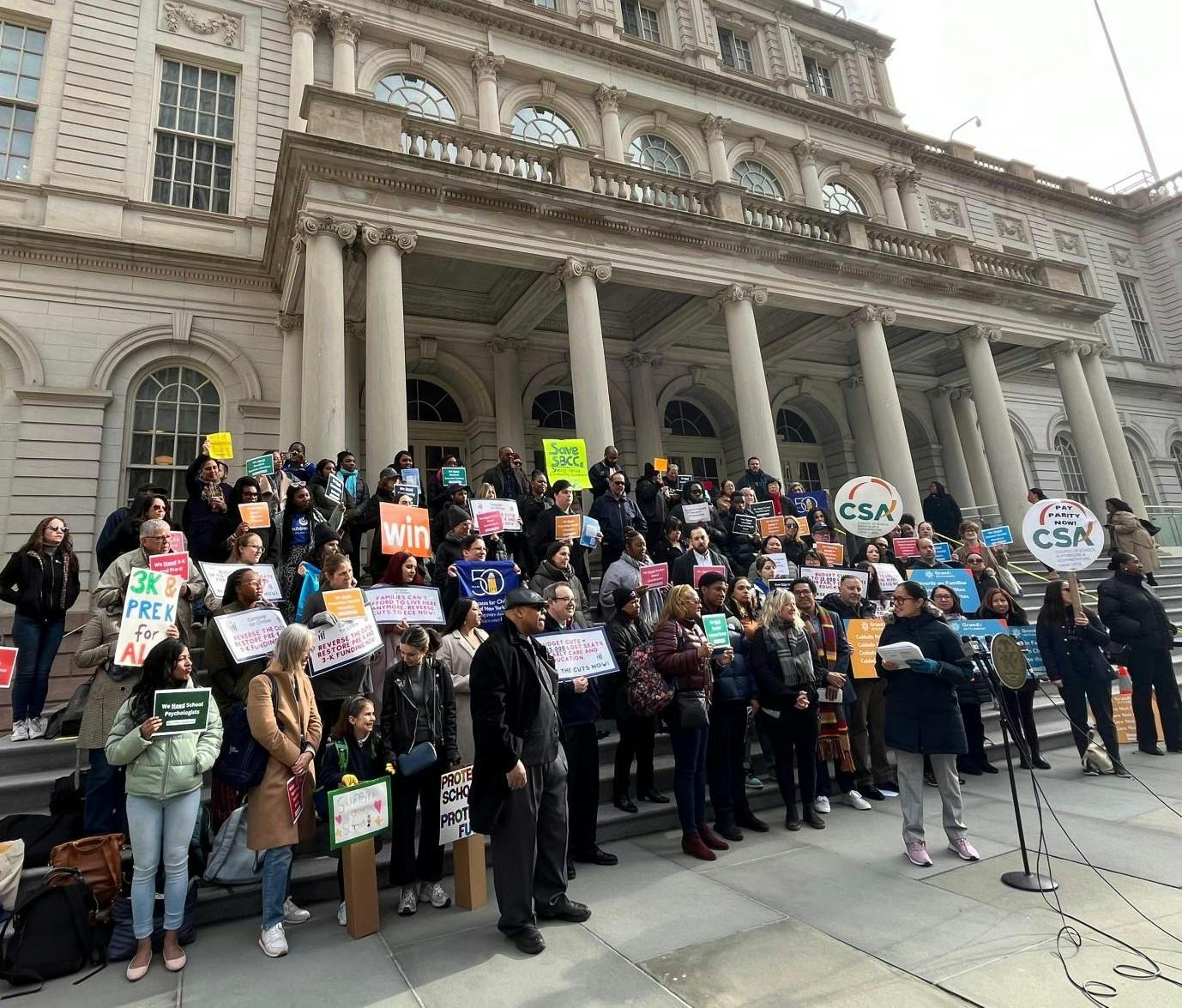

Child Care, Workforce Attachment, and CCC’s Persistent Role
Insights
March 26, 2024
The city’s free 3-K and Pre-K programs serve as lifelines for ALL families trying to make ends meet; we have to protect funding that invests in working families and, specifically, working mothers.
Last week, advocates, providers, and parents gathered on the steps of City Hall (pictured below) to rally against cuts to the Department of Education that amount to millions of dollars removed from the city’s free 3-K and Pre-K system. The rally centered experiences of working mothers finding care for their young children, and the economic challenges that come with this decision when affordable options are not available.

CCC’s data analysis and policy solutions around early childhood education, as well as strong partnerships with other organizations, continue to help define the severity and importance of the child care situation in NYC. In fact, since our founding in 1944, CCC has participated in meaningful child care advocacy, and an important, persistent throughline within child care discussions—made further evident through media coverage on the March 18 rally—has been about women’s participation in the workforce. Workforce participation is both an integral piece of economic security for families and a critical topic for Women’s History Month (and beyond). Over the past 80 years, CCC has been an unwavering proponent of child care access and workforce participation for women, as both deeply influence child well-being. Our work continues today and feels more pressing than ever with timely data on women, financial wellness, and child care highlighting the connections.
Child Care can be affordable for all—it once was!
“The closing of child care centers throughout the country certainly is bringing to light the fact that these centers were a real need.” – Eleanor Roosevelt, “My Day” column, September 8, 1945
At one point in U.S. history, child care programming was provided as a free benefit to support working women. In 1943, Congress allocated funds to create the nation’s first and only universal childcare program that would care for the young children of mothers called by the government to enter the workforce during WWII. When news came that the programs would be ending in 1945, parents sent letters, wires, postcards, and petitions urging the government to keep the child care centers open. CCC founder Eleanor Roosevelt also received letters from mothers on this topic. Mrs. Roosevelt was a supporter herself of maintaining the wartime child care program as a means to better the lives of children and families—she wrote about her support for continued child care access in a September 1945 “My Day” column, citing letters she had received from working mothers. Advocates like Mrs. Roosevelt understood that child care access was connected to economic stability for families. And it was the overall understanding that child care impacted community prosperity and child well-being that helped motivate her and her colleagues to found CCC.
What this history tells us is that accessible child care is both achievable and deeply connected to economic health. Post-WWII, women’s workforce participation has only gotten stronger, and we need an early childhood education system that is growing to keep pace with this reality, not shrinking. In New York City today, conversations about child care have grown louder in the face of funding cuts to 3-K, Pre-K, and the Department of Education as well as a rapidly deepening affordability crisis, wherein child care is a major financial burden on 80% of NYC families. You can read more about just how unaffordable child care currently in our data analysis on child care cost.
Child Care Access Protects Economic Health for Working Mothers
Overall, workforce attachment for all parents is threatened by unreliable access to affordable child care and by systems that keep providers strapped themselves. Recently, a Cornell University study of families in New York found that two out of five surveyed parents have opted to leave their job and stay home to care for their child due to the high cost of care. Going deeper, however, there is disparity in how child care impacts working mothers vs working fathers based on a few factors. Within the child care industry itself, women are the overwhelming majority of providers. Across New York, 94% of providers are women and 58% are women of color. Furthermore, most child care workers in New York earn less than the median wage; 1 in 4 in NYC live in poverty and more than half qualify for child care subsidies for their own children. These low wages, on top of the demographics of the industry, therefore, exacerbate existing patterns of economic, gender, and racial inequality. This is also significant considering the overall history of working women in the U.S.—for instance, throughout U.S. history, Black women comparatively have always had the highest levels of job market participation regardless of age, marital status, or presence of children at home, while overall women of color tend to be overrepresented in service jobs like child care.
The city’s own data likewise reveals that two-thirds of NYC parents who have left or anticipate leaving their jobs due to child care are women. Previous Census data showed us that women living with children were 2 ½ times more likely to cite child care as the reason for being out of work. And overall, departure from the workforce due to child care has long-term impact on lifetime earnings, making child care a pay equity issue for women. In fact, data presented in Stanford’s RAPID Survey (a survey on Early Childhood) also showed that most mothers who cut back on work due to child care needs did so even though they didn’t have adequate income without it. For many working families, the cost of care is just eating up too much of their budget. With child care costing between $14,000 and $20,000 on average in NYC, sometimes even more, there is a tradeoff between work and child care for many households and families with lower earnings, especially since the median household income for all families in NYC is about $86,000, and it’s lower for single parents. This is particularly true for single mothers.

Saying No to Child Care Cuts
Post-WWII, women’s workforce participation has only gotten stronger, and we need an early childhood education system that is growing to keep pace with this reality, not shrinking.
In honor of Women’s History Month and to support our NYC communities, you can take action right now to help strengthen opposition to these cuts and urge the Mayor to reverse cuts that undermine economic stability for millions of families across the five boroughs. Signing our letter campaign to reject cuts to child care takes just 2 minutes!


